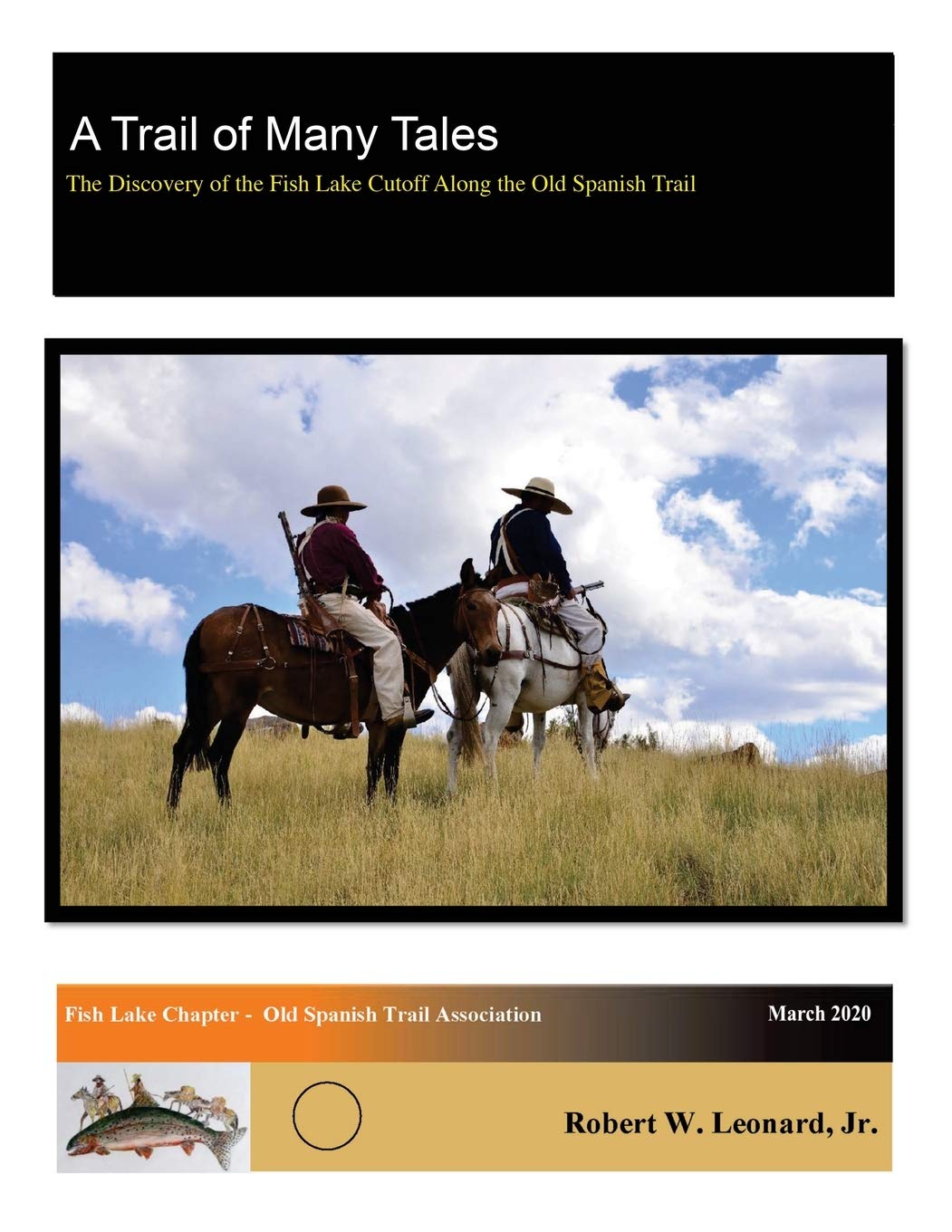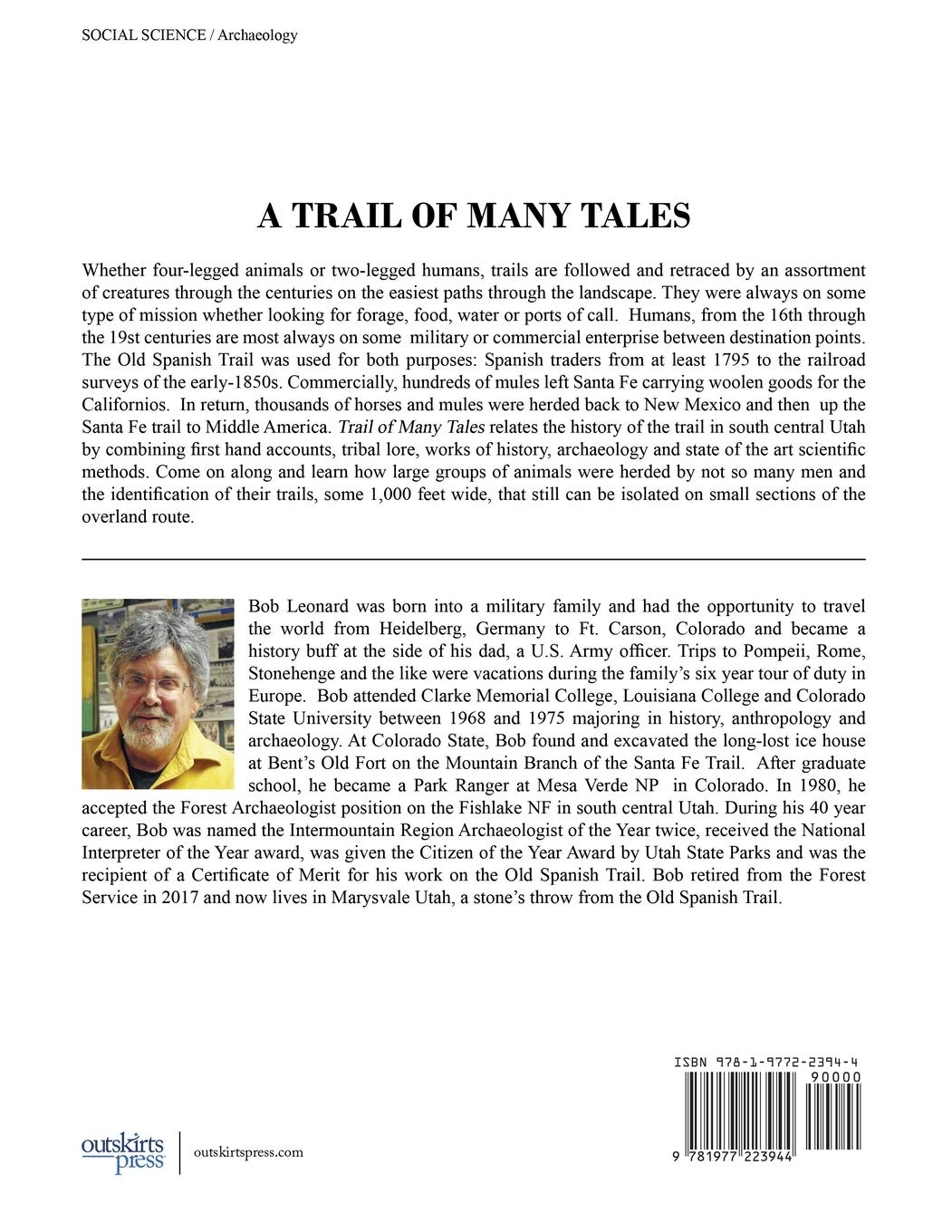(Click and hold the slider icon on the image below to view front and back covers.)


OFFICIAL DESCRIPTION*:
Whether four-legged animals or two-legged humans, trails are followed and retraced by an assortment of creatures through the centuries on the easiest paths through the landscape. They were always on some type of mission whether looking for forage, food, water, or ports of call. Humans, from the 16th through the 19th centuries were most always on some military or commercial enterprise between destination points. The Old Spanish Trail was used for both purposes: Spanish traders from at least 1795 to the railroad surveys of the early-1850s. Commercially, hundreds of mules left Santa Fe carrying woolen goods for the Californios. In return, thousands of horses and mules were herded back to New Mexico and then up the Santa Fe trail to Middle America.
Trail of Many Tales relates the history of the trail in south central Utah by combining first-hand accounts, tribal lore, works of history, archaeology and state of the art scientific methods. Come on along and learn how large groups of animals were herded by not so many men and our identification of their trails, some 1,000 feet wide, that still can be isolated on small sections of the overland route.
REVIEW:
Have you ever spent time obsessing over Wagon Train stories or settlement in the American West–either digitally or as a traveler yourself? Have you spent an absurd amount of time going down the rabbit hole that is Wikipedia when it comes to interesting historical events or social histories? I have, and chances are some of my readers here have done so, too. This book is for you, my rabbit hole and history buff readers!
In structure, A Trail of Many Tales: The Discovery of the Fish Lake Cutoff Along the Old Spanish Trail combines the best features of both academic publications and the sort of widely-used guide books that show up on library shelves. Speaking from my experience checking out books for library visitors, the Falcon Guides book on Italy is extremely popular, but all books of this nature, especially the local or regional ones, are much-looked-for by readers and travelers. This makes Robert W. Leonard, Jr.’s A Trail of Many Tales both extraordinarily practical for those wishing to know more about its story or are hiking in the area, and extremely authoritative and trustworthy from a technical or academic perspective. Photographs pepper sections where they provide both an oft-needed “sense of place” and examples of the sorts of modern remnants of the area’s usage at its several peaks. Everything is properly credited in the academic fashion with short descriptive captions, so the images are both enjoyable from a casual standpoint and compliant with copyright from an academic one. Many of them were taken by the author himself while researching the routes.
The written sections are, I promise you, highly readable due to the author Leonard’s straightforward style of expression, but non-academic readers ought to be able to sense from the outset that the book wasn’t written entirely with them in mind, and that there are some structural differences between the architecture of scholarly publications and commercially produced guides. As an example, the book provides table of contents instead of the more simple chapter listings of creative travelogue nonfiction (I’m thinking here of Travels in Siberia, which I read a couple of years ago, as a popular example of that particular form.) Only the very occasional typo (probably from word processors’ tendency to transpose letters) would indicate that this book didn’t have a bevy of interns and salaried editors scrutinizing every line. There are also some acronyms and unfamiliar terms to those of us not terribly familiar with the sort of technologies available in the 1800s–Terms like swales or the Dixie Harrow project, some Bureau of Land Management and National Forest Service acronyms I didn’t immediately recognize, and some other technical terms that sent me straight to the Index and Appendices included at the very end of the book …. as well as my graduate work at the University of Arizona, where I spent considerable time in various laboratories conducting some writerly research of my own.
Despite its (very occasional) quirks, A Trail of Tales was absolutely engrossing. I got so sucked in by the various histories and experiences of the Old Spanish Trail (acronym: OST) that I stayed up past 3 in the morning reading and re-reading several sections, including the area’s regional pre-Columbus slave trade (horrifying in a True Crime sort of fashion) and its historical importance to the Church of Latter-Day Saints. And let me tell you, I sacrifice my sleep only for the most interesting and readable of books. If I have made any typos in my review, I blame several late nights obsessing over this book. And tree rings. And public land management in America. I have been known to fall asleep even before finishing a single article in home decoration magazines–usually before 10 in the evening–so you get a sense of how this book reeled me right in.
SIDE NOTE: the Laboratory of Tree-Ring Research there is absolutely fabulous as both a building and a research institution. It provides a brief summary of the basics of tree-ring research, including some of the technical terms used in this book, on the “About Tree Rings” page on their website as well as by live virtual tours of the building that help give digital visitors a better sense of the place; the Laboratory also makes available live virtual tours of the building for students. (I’ll admit, since March of 2020 the existence of virtual tours was not a fact that I regularly thought about; since COVID-19 has shut down public access to many, many important places, such as the major museums of Europe, the Smithsonian, and even some restaurants have become much more popular–and useful. Useful to, for example, the future college freshmen wanting to know what sort of campus they’ll choose to land on, once on-site learning picks up again.)
While I do think that there is a great deal to interest a wide readership in A Tail of Trails, I know for certain that travelers–both serious hikers and tourists for history like those who follow any of the Wagon Trail routes to the American West)–as well as researchers and American history buffs will find it of particular importance. Author and fellow-traveler–not to mention researcher–Leonard does a great job of contextualizing the Old Spanish Trail and this book’s specific sections of the OST within the larger history of migration (whether the trafficking of slaves or white settlers and adventurers). I feel like I understand the place, what it means to different people as well as a detailed understanding of what it would be like to stand on a riverbank in Tommy Hollow. I’m so glad this book came to my attention, and to have a chance to read it!
IN SUMMARY:
In A Trail of Many Tales: The Discovery of the Fish Lake Cutoff Along the Old Spanish Trail, author Robert W. Leonard, Jr. leads his readers through the documented history and his own boots-on-the-grounds research of a well-used (historically speaking, at least) shortcut of the Old Spanish Trail. Up until the publication of Leonard’s book, there had been no widespread awareness of this cutoff’s importance or its popularity and its usage as a Pre-Columbus trade route between New Mexico (who supplied, among other things, textiles and mules) and California as well as the traders residing in the Fishlake National Forest’s area (who provided, among other things, Indigenous peoples as slaves for manual labor). The author provides a fascinating look into the world of dendrochronology and other scientific research, and keeps readers hooked by his own compelling obsession with–and research trips to–the cutoff and surrounds. I could not have stumbled across either a more interesting guide book or–bonus feature!–a more thorough and authoritative work of historical or scientific research. A Trail of Tales is a fantastic book.
WHERE TO BUY?
You can find A Trail of Many Tales: The Discovery of the Fish Lake Cutoff Along the Old Spanish Trail by Robert W. Leonard, Jr. wherever good books are sold, including Bookshop.org, Barnes & Noble and Amazon. You can also find out more about it on the book’s Outskirts Press listing.
WHAT NEXT?
Oh, don’t get me started! I have over twenty items checked out from my local library and a score of non-library books in poorly-organized piles around my physical space … and digital ebook space. Many of these (ten, maybe?) I have already started, but thanks to … (*gestures at all of 2020*) … I have the attention span of a restless cat, so I’m reading them all at once or a bit at a time, sequentially. I don’t have a specific one I’d pull out of that pile quite yet for my next review––but I have a lot of candidates jostling for the space. Very likely I’ll have to keep up a rapid pace with my reviews over the coming months. Thank you for reading my review, and I hope you are able to read this book yourself!
I received a copy of this book in exchange for an honest review.
* Courtesy of Bookshop.org book listing.

